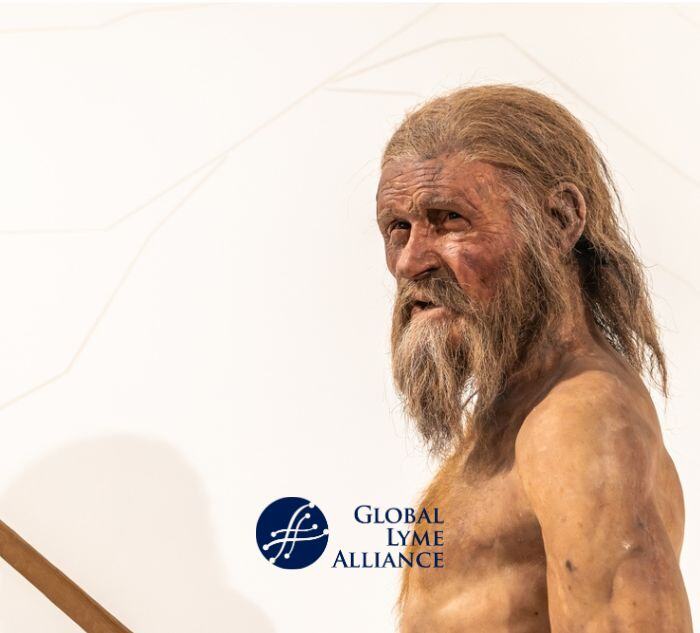
Discover the ancient origins of Lyme disease through Ötzi the Ice Man's story, an "intriguing investigative lead" shedding light on the history of Lyme. Learn how research on this 5300-year-old man is shaping our understanding of modern Lyme disease.
Part of Lyme Disease Awareness Month is spreading facts about a disease that is often shrouded in myth. One such myth is that Lyme is a relatively new illness, which is why science is only just beginning to catch up to the lived experience. Lyme disease was officially named when a cluster of cases popped up in Lyme, Connecticut in the mid-1970s. However, its history goes back much farther than that.
A similar illness was described in Europe earlier in the 20th century, and for years before that, people had been complaining of the “Nantucket flu.” But a discovery in the Ötzal Alps—near the current border of Austria and Italy—tells us that Borrelia burgdorferi, the bacterium that causes the infection now known as Lyme disease, goes back some 5300 years. And other research now shows that Borrelia burgdorferi actually dates back 60,000 years in New England!
In 1991, German hikers discovered “Ötzi the Ice Man”, who was probably about 45 years old when he died from an arrow wound 5300 years ago. Researchers have been able to determine fascinating details about Ötzi, such as what he had for breakfast on the day he was killed and what types of loin cloths he preferred. He likely had brown eyes and type O blood. The most scientifically significant discovery about Ötzi, though, is that DNA analysis showed evidence of Borrelia burgdorferi in his bones.
I thought suffering for eight years before getting accurately diagnosed with Lyme disease, babesiosis, and ehrlichiosis was bad enough. But it turns out humans have been suffering with tick-borne illness—possibly battling similar symptoms and the frustration and confusion that come with them—for centuries. Ötzi is proof that Lyme is so much bigger than our current scope of it, and that there is still much to be learned about the disease.
As GLA-funded researcher Dr. Steven Schutzer, a lead investigator on a National Institutes of Health-funded project that has sequenced strains of Borrelia burgdorferi, said in a 2012 Live Science interview, the discovery of Borrelia burgdorferi in Ötzi’s bones is “an intriguing investigative lead.” Ötzi’s case has since encouraged researchers to explore the question of how Lyme disease affects the bones. A team at the University of Toronto’s Faculty of Dentistry found that “The bacteria were not only detectable in the bones of mice, they were seen to cause significant bone loss in the longer bones, mere weeks after infection…The study found that the amount of bone loss directly correlated to the bacterial load found in the bones. The more bacteria present, the greater the bone loss.”[i]
This finding is significant for Lyme patients who have long suffered from osteoarthritis or osteoporosis. It makes me wonder, what else can scientists learn from a 5300-year-old man that can help our understanding of modern Lyme disease? What else do we not yet know about this illness?
Tick-borne disease itself, it turns out, is much older than we think. A team of scientists led by the Yale School of Public Health sequenced the full genomes of Borrelia burgdorferi and found that its evolutionary tree goes back 60,000 years in New England. A report on this work states, “The finding shows that the ongoing Lyme disease epidemic was not sparked by a recent reintroduction of the bacterium or an evolutionary change—such as a mutation that made the bacterium more readily transmissible. It is tied to the ecological transformation of much of North America.”[ii] To me, this discovery is substantial (and a bit mind-blowing!) because it proves the impact that ecological and climate change have had on the rising threat of tick-borne disease.
With the help of Ötzi and researchers, many funded by GLA, great strides are being made in understanding of Lyme and other tick-borne disease. As a Lyme patient, this gives me hope. Perhaps in 5300 years—or far less time—Lyme will be a thing of the past.
For more on what Lyme Disease Awareness Month means to me personally, see my blog “What Does Lyme Disease Awareness Month Mean to Me? A Lyme Warrior Reflects.”
[i] https://www.utoronto.ca/news/u-t-researchers-find-ancient-iceman-s-infection-helps-lyme-disease-bone-loss-discovery
[ii] https://medicine.yale.edu/news-article/ancient-history-of-lyme-disease-in-north-america-revealed-with-bacterial-genomes/
***

Jennifer Crystal
Writer
Opinions expressed by contributors are their own. Jennifer Crystal is a writer and educator in Boston. Her work has appeared in local and national publications including Harvard Health Publishing and The Boston Globe. As a GLA columnist for over six years, her work on GLA.org has received mention in publications such as The New Yorker, weatherchannel.com, CQ Researcher, and ProHealth.com. Jennifer is a patient advocate who has dealt with chronic illness, including Lyme and other tick-borne infections. Her memoir, One Tick Stopped the Clock, was published by Legacy Book Press in 2024. Ten percent of proceeds from the book will go to Global Lyme Alliance. Contact her via email below.
